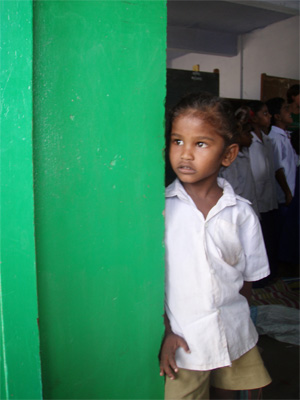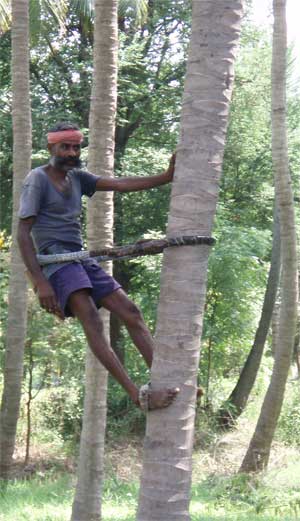TABLE
OF CONTENTS
|
India: A Country of Extremes
By Lindsay Kuhlmann
 It
was hard to ignore the severe differences in wealth that I saw in India.
The first day I arrived I rode by shanties that had been erected in the
middle
of Chennai. These huts had no electricity or running water and looked
as if in
moments they would collapse. Cows accompanied many of the huts and once
the
streets became dark the people without shelter slept on the streets
next to the
dismal housing. I was able to see first hand the scene described in Planet of Slums as “the dumping ground
for those urban residents whose labor is wanted in the urban economy
but whose
visual presence should be reduced as much as possible (pg 172, Davis).” It
was hard to ignore the severe differences in wealth that I saw in India.
The first day I arrived I rode by shanties that had been erected in the
middle
of Chennai. These huts had no electricity or running water and looked
as if in
moments they would collapse. Cows accompanied many of the huts and once
the
streets became dark the people without shelter slept on the streets
next to the
dismal housing. I was able to see first hand the scene described in Planet of Slums as “the dumping ground
for those urban residents whose labor is wanted in the urban economy
but whose
visual presence should be reduced as much as possible (pg 172, Davis).”
 Everywhere I ventured I saw
beggars on the
streets that would aggressively approach me for money. Yet this action
only
lasted as far as the city limits. During my short time in India
I also did a home stay in Erode,
India.
The home was in a small village. My stay in the village was peaceful
and, while
I was stared at, I was never asked for money. There seemed to be a
sense of
contentment for life in the village. The people were not determined to
take
advantage of me. It was the India
that I was hoping to see. I hypothesize that perhaps this has something
to do
with a vernacular status quo versus a transnational status quo. It
seemed that
in the cities people were exposed to a materialism that made people
feel
they needed more. Whereas the countryside it was acceptable to be
happy with
what you have. This isn’t to say that people don’t work to gain
material goods in rural India
but it may mean that material goods are not as important to obtain. I
am not
sure if the five days in India
gave me clear picture of the country and perhaps this theory would
change if I
spent more time there. But right now this is my view of India. Everywhere I ventured I saw
beggars on the
streets that would aggressively approach me for money. Yet this action
only
lasted as far as the city limits. During my short time in India
I also did a home stay in Erode,
India.
The home was in a small village. My stay in the village was peaceful
and, while
I was stared at, I was never asked for money. There seemed to be a
sense of
contentment for life in the village. The people were not determined to
take
advantage of me. It was the India
that I was hoping to see. I hypothesize that perhaps this has something
to do
with a vernacular status quo versus a transnational status quo. It
seemed that
in the cities people were exposed to a materialism that made people
feel
they needed more. Whereas the countryside it was acceptable to be
happy with
what you have. This isn’t to say that people don’t work to gain
material goods in rural India
but it may mean that material goods are not as important to obtain. I
am not
sure if the five days in India
gave me clear picture of the country and perhaps this theory would
change if I
spent more time there. But right now this is my view of India.
|

 It
was hard to ignore the severe differences in wealth that I saw in
It
was hard to ignore the severe differences in wealth that I saw in  Everywhere I ventured I saw
beggars on the
streets that would aggressively approach me for money. Yet this action
only
lasted as far as the city limits. During my short time in
Everywhere I ventured I saw
beggars on the
streets that would aggressively approach me for money. Yet this action
only
lasted as far as the city limits. During my short time in